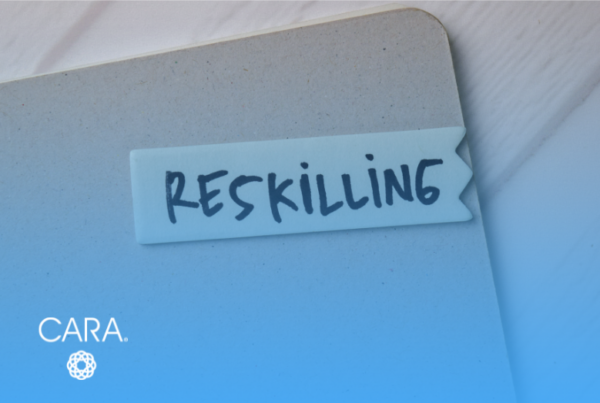
In today’s dynamic landscape, change is not only happening, it’s accelerating. This places immense pressure on organizations to adapt and evolve. The responsibility to navigate this very turbulent landscape falls squarely on the shoulders of leaders. In the quest to drive successful business outcomes, companies continue to invest in change methodologies, tools and training for their employees. However, the data shows that 75% percent of ambitious change programs fail to capture long-term value. Despite these grim odds, global organizations spend $10B annually on change management efforts. Where are we getting it wrong? Could clarification of two terms help us to achieve a significant unlock?
Navigating the complexity of change requires more than methodology and tools. It demands a strategic approach that accounts for both the intricacies of organizational systems and the human dynamics that fuel them. This is where the terms: “change management” and “organizational change management” (OCM) come into play.
Organizational Change Management vs. Change Management: Is There a Difference?
While often used interchangeably, these terms have distinct meanings but are not mutually exclusive. Combined, they make a world of difference in creating sustainable change. Getting clear on the “how’ and “why” is not only a game changer for organizations with big aspirations for transformation, but also an imperative. Understanding key distinctions between change management and OCM will help you foster synergy between the two, charting your transformational roadmap with greater confidence and success. Read on and I’ll share some more specifics.
Change management is about the “how” of implementing specific change initiatives, while OCM is about the “why” and “what” of change. OCM’s focus is building a change culture that considers organizational context and people dynamics. Let’s break it down a bit further.
What is Change Management?
Change management is the strategy, process and tactics of implementing and adopting change within a project or initiative. It’s about the tools and techniques used to guide individuals and teams through the transition from a current state to a desired future state. Initiatives suited for a pure change management focus are typically smaller in scale and have set timelines and goals.
Let’s say your business is implementing a new customer relationship management (CRM) platform across the entire sales team. Processes, outcomes and roles are well-defined around this change. It is perceived by the organization as a lift and shift to a more efficient, automated approach. Leveraging a change management strategy will lead to a successful adoption of the new CRM system by focusing on the following:
- Process: Planning and executing the roll-out of the new software that includes training, communication and troubleshooting support.
- Communications: Informing the sales team of system deployment timelines and the overall change roadmap.
- Training and tools: Using guides, online tutorials and support technicians
- Individual transitions: Ensuring the sales reps adapt to the new interface while managing potential change resistance.
What is Organizational Change Management (OCM)?
Organizational change management is a longer-term, holistic philosophy aimed at increasing change capacity and capability at an enterprise level to thrive throughout constant change. Large-scale organizational impacts usually mean leaders must prepare for major changes to their processes, culture, strategy and tech stack.
Organizational change management is ideal for substantial organizational and cultural changes such as digital implementations, ERP implementations, and company mergers and acquisitions. Deploying an OCM philosophy will foster a cohesive, high-performing workforce across all departments by:
- Unifying culture: Aligning team values and goals fosters collaboration and communication between previously separate groups.
- Creating structure: Restructuring teams, roles and responsibilities provides a transparent roadmap for each employee — giving them a clear understanding of their job so they can confidently work.
- Empowering leadership: Helping leadership teams navigate the transition and teaching them how to address concerns will build trust amongst team members.
Leadership and Organizational Development: What You Need to Know
You can have one and not the other, but both change management and organizational change management are crucial for successful transformational change. Effective transformation requires a structured approach to change (change management) and a focus on the human and broader organizational elements (OCM).
Leaders should think of change management as their navigation system. It provides directions for a specific project or initiative. Change management focuses on the practical aspects of implementing change, ensuring a smooth and efficient transition, including:
- Planning and analysis: Assessing the impact of change, identifying potential roadblocks and developing strategies to mitigate them.
- Communication and engagement: Keeping stakeholders informed, addressing concerns and fostering buy-in.
- Training and support: Equipping employees with the skills and knowledge to adopt new processes or technologies.
- Deployment and monitoring: Rolling out the change in a controlled manner, tracking progress and adjusting as needed.
Organizational change, however, is more like an architectural map. It helps you visualize and consider your entire landscape — organizational climate, infrastructure and culture — to inform how you evolve your OCM strategy and maturity over time. OCM is not just a one-time event. It’s an ongoing process that requires sustained leadership commitment, investment and support with:
- Aligning change with organizational culture and values: Ensuring the new direction resonates with employees and strengthens the organization’s identity.
- Understanding people’s reactions to change: Addressing resistance, managing anxieties and building trust.
- Developing long-term capability for change: Fostering an adaptable and resilient workforce equipped to embrace future transformations.
- Building change leadership: Empowering individuals at all levels to champion and drive change initiatives.
- Measuring and course correction: Regularly assess the impact of change and be willing to adapt strategies based on feedback and results.
Transformational changes require more than communications and training. Human dynamics at an individual, team and the broader organization must be addressed, and the approach should be tailored to your organizational environment.
Transformational change is impacted by individual behaviors, mindsets, beliefs, company culture and how successfully your organization is set up for change. This is where leaders need to consider their change “long-game” and invest in capabilities that will equip the organization for larger-scale, continuous and more pervasive changes through an OCM strategy. Here is where OCM and change management meet with the support of a defined change methodology, playbook, toolkit and education tailored to specific organizational needs and context.
How to Implement Change: 4 Areas for Leaders to Consider
Choosing to implement change management, OCM or both can be tricky. Ultimately, both guide successful transitions and sustained change within an organization. Leaders should consider several key factors to decide which approach is most suitable for their specific situation:
Urgency and scope of change:
- Change management is most appropriate for smaller, specific projects with a defined timeline and deliverables or if you need to implement a quick, targeted change with minimal disruption.
- OCM is the choice for holistic, long-term transformations or if you’re undergoing a significant shift in strategy, culture or technology.
Level of employee resistance:
- Change management employs tactics like stakeholder engagement and communication to address resistance at the individual level. If you expect moderate resistance to the change, change management can help manage concerns and promote adoption.
- OCM addresses resistance on a systemic level by analyzing organizational culture, power dynamics and historical change initiatives. OCM’s deeper analysis and broader focus are invaluable for overcoming significant resistance.
Leadership commitment and communication:
- Both change management and OCM require strong leadership commitment to ensure successful implementation. Leaders must champion the change, communicate effectively and address concerns throughout the transformation.
- OCM places even greater emphasis on leadership visibility and consistent communication. Navigating large-scale change requires constant engagement and buy-in from all levels.
Organizational maturity and change history:
- Change management works well in organizations with a culture of adaptability and a positive track record of implementing small-scale changes.
- OCM is often necessary for organizations with deeply entrenched practices or a history of failed change initiatives. OCM’s systemic approach helps address underlying obstacles and create a sustainable foundation for transformation.
These are just some guiding factors, and the best approach might involve a combination of change management and OCM strategies tailored to your specific context. Imagine fusing these two forces. The individual gets the support they need to navigate the unknown. The organization creates a clear and supportive environment for them to thrive. That’s synergy in action — the missing ingredient to driving successful change.
By wielding the combined power of change management and OCM, you can transform the change experience from a chaotic struggle to a collaborative, empowering journey. Leaders can not only manage change but drive it with remarkable results. You can enable your organization to evolve with confidence.
Benefits of Partnering with an Organizational Change Management Consultant
OCM consultants can help build a comprehensive change management strategy that will help you meet your organization’s unique needs and goals.
The CARA Group’s OCM experts provide value-driven solutions that achieve real business outcomes. We create a tailored roadmap with the help of proven practices and deliverables like change impact and readiness assessments, stakeholder management, leadership engagement and resistance management. We help clients navigate the complexities of change for projects big and small. Let’s chat about your company’s organizational change management needs.
Let’s chat————————————————————————————–
FAQs
Q: What are the principles of change management and OCM?
Change management is focused on an individual project, department, or team. Change management and project management are often paired to achieve successful project outcomes. Prosci states, “Change management and project management are complementary disciplines that share a common objective: to deliver successful change.”
OCM intends to develop a change-agile culture within an organization which is an environment that embraces change, adapts quickly, and fosters continuous learning for everyone involved. OCM is here for the long-term health of the company. Its main goal is to transform culture and capabilities so the organization can embrace change as a continuous process, not just related to implementing specific initiatives.
At a foundational level:
- Change management is project-oriented, while OCM is organization-wide.
- Change management is tactical, while OCM is strategic.
- Change management has a defined timeframe, while OCM is ongoing.
- Change management delivers project or program-level outcomes. OCM creates sustained adoption and business transformation.
Q: What are the benefits of organizational change management?
OCM’s value can be measured by multiple factors like the speed at which an organization adapts to changes, if the desired change is sustained and if the organization reaches its future state. Specific ROI metrics can also be set against OCM engagements.
Q: How to best implement transformational change?
Depending on the focus, scope, methodology, and desired outcomes, business leaders must fully understand their change environment – their organization’s change readiness, leadership alignment, and stakeholder management. From there, a tailored roadmap can be constructed with customized tools and communication plans that train, upskill, prepare and support the organization. OCM consultants can help business leaders architect their change frameworks by managing all the above and by helping to build a change-agile and resilient culture.
RESEARCH:
- https://bcghendersoninstitute.com/familiar-yet-fatal-10-common-pathologies-of-failed-change-efforts/
- https://www.bcg.com/publications/2017/change-management-getting-smart-about-change-management
- ALM Intelligence, Competitive Landscape Analysis: Change Management Consulting, 2016
- https://www.quora.com/What-is-the-difference-between-Organizational-Development-Organizational-Change-Management-and-Change-Management
- https://www.prosci.com/blog/change-vs-change-management
- https://serviceaide.com/resources/blog/understanding-it-change-management-vs-organizational-change
- https://www.linkedin.com/pulse/change-management-organizational-same-thing-stratadice/
- https://daniellock.com/the-difference-between-change-management-and-organizational-development/
- https://online.hbs.edu/blog/post/organizational-change-management
- https://www.prosci.com/blog/change-management-and-project-management-comparison
- What We Mean by Organizational Change Management (prosci.com)
- What is organizational change management (OCM)? | Definition from TechTarget



